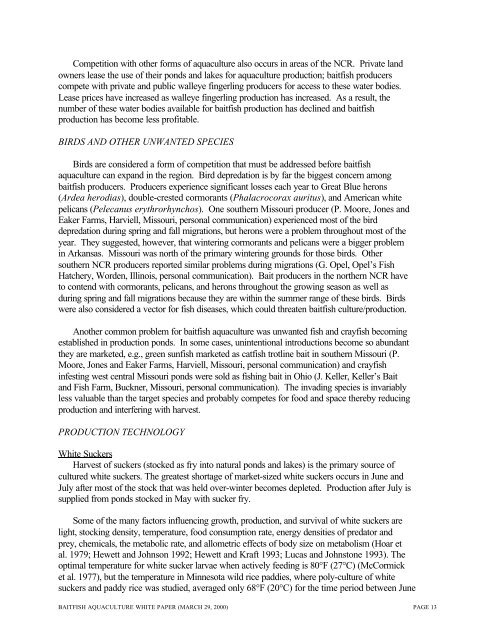a white paper on the status and needs of baitfish ... - NCRAC
a white paper on the status and needs of baitfish ... - NCRAC
a white paper on the status and needs of baitfish ... - NCRAC
Create successful ePaper yourself
Turn your PDF publications into a flip-book with our unique Google optimized e-Paper software.
Competiti<strong>on</strong> with o<strong>the</strong>r forms <strong>of</strong> aquaculture also occurs in areas <strong>of</strong> <strong>the</strong> NCR. Private l<strong>and</strong><br />
owners lease <strong>the</strong> use <strong>of</strong> <strong>the</strong>ir p<strong>on</strong>ds <strong>and</strong> lakes for aquaculture producti<strong>on</strong>; <strong>baitfish</strong> producers<br />
compete with private <strong>and</strong> public walleye fingerling producers for access to <strong>the</strong>se water bodies.<br />
Lease prices have increased as walleye fingerling producti<strong>on</strong> has increased. As a result, <strong>the</strong><br />
number <strong>of</strong> <strong>the</strong>se water bodies available for <strong>baitfish</strong> producti<strong>on</strong> has declined <strong>and</strong> <strong>baitfish</strong><br />
producti<strong>on</strong> has become less pr<strong>of</strong>itable.<br />
BIRDS AND OTHER UNWANTED SPECIES<br />
Birds are c<strong>on</strong>sidered a form <strong>of</strong> competiti<strong>on</strong> that must be addressed before <strong>baitfish</strong><br />
aquaculture can exp<strong>and</strong> in <strong>the</strong> regi<strong>on</strong>. Bird depredati<strong>on</strong> is by far <strong>the</strong> biggest c<strong>on</strong>cern am<strong>on</strong>g<br />
<strong>baitfish</strong> producers. Producers experience significant losses each year to Great Blue her<strong>on</strong>s<br />
(Ardea herodias), double-crested cormorants (Phalacrocorax auritus), <strong>and</strong> American <str<strong>on</strong>g>white</str<strong>on</strong>g><br />
pelicans (Pelecanus erythrorhynchos). One sou<strong>the</strong>rn Missouri producer (P. Moore, J<strong>on</strong>es <strong>and</strong><br />
Eaker Farms, Harviell, Missouri, pers<strong>on</strong>al communicati<strong>on</strong>) experienced most <strong>of</strong> <strong>the</strong> bird<br />
depredati<strong>on</strong> during spring <strong>and</strong> fall migrati<strong>on</strong>s, but her<strong>on</strong>s were a problem throughout most <strong>of</strong> <strong>the</strong><br />
year. They suggested, however, that wintering cormorants <strong>and</strong> pelicans were a bigger problem<br />
in Arkansas. Missouri was north <strong>of</strong> <strong>the</strong> primary wintering grounds for those birds. O<strong>the</strong>r<br />
sou<strong>the</strong>rn NCR producers reported similar problems during migrati<strong>on</strong>s (G. Opel, Opel’s Fish<br />
Hatchery, Worden, Illinois, pers<strong>on</strong>al communicati<strong>on</strong>). Bait producers in <strong>the</strong> nor<strong>the</strong>rn NCR have<br />
to c<strong>on</strong>tend with cormorants, pelicans, <strong>and</strong> her<strong>on</strong>s throughout <strong>the</strong> growing seas<strong>on</strong> as well as<br />
during spring <strong>and</strong> fall migrati<strong>on</strong>s because <strong>the</strong>y are within <strong>the</strong> summer range <strong>of</strong> <strong>the</strong>se birds. Birds<br />
were also c<strong>on</strong>sidered a vector for fish diseases, which could threaten <strong>baitfish</strong> culture/producti<strong>on</strong>.<br />
Ano<strong>the</strong>r comm<strong>on</strong> problem for <strong>baitfish</strong> aquaculture was unwanted fish <strong>and</strong> crayfish becoming<br />
established in producti<strong>on</strong> p<strong>on</strong>ds. In some cases, unintenti<strong>on</strong>al introducti<strong>on</strong>s become so abundant<br />
<strong>the</strong>y are marketed, e.g., green sunfish marketed as catfish trotline bait in sou<strong>the</strong>rn Missouri (P.<br />
Moore, J<strong>on</strong>es <strong>and</strong> Eaker Farms, Harviell, Missouri, pers<strong>on</strong>al communicati<strong>on</strong>) <strong>and</strong> crayfish<br />
infesting west central Missouri p<strong>on</strong>ds were sold as fishing bait in Ohio (J. Keller, Keller’s Bait<br />
<strong>and</strong> Fish Farm, Buckner, Missouri, pers<strong>on</strong>al communicati<strong>on</strong>). The invading species is invariably<br />
less valuable than <strong>the</strong> target species <strong>and</strong> probably competes for food <strong>and</strong> space <strong>the</strong>reby reducing<br />
producti<strong>on</strong> <strong>and</strong> interfering with harvest.<br />
PRODUCTION TECHNOLOGY<br />
White Suckers<br />
Harvest <strong>of</strong> suckers (stocked as fry into natural p<strong>on</strong>ds <strong>and</strong> lakes) is <strong>the</strong> primary source <strong>of</strong><br />
cultured <str<strong>on</strong>g>white</str<strong>on</strong>g> suckers. The greatest shortage <strong>of</strong> market-sized <str<strong>on</strong>g>white</str<strong>on</strong>g> suckers occurs in June <strong>and</strong><br />
July after most <strong>of</strong> <strong>the</strong> stock that was held over-winter becomes depleted. Producti<strong>on</strong> after July is<br />
supplied from p<strong>on</strong>ds stocked in May with sucker fry.<br />
Some <strong>of</strong> <strong>the</strong> many factors influencing growth, producti<strong>on</strong>, <strong>and</strong> survival <strong>of</strong> <str<strong>on</strong>g>white</str<strong>on</strong>g> suckers are<br />
light, stocking density, temperature, food c<strong>on</strong>sumpti<strong>on</strong> rate, energy densities <strong>of</strong> predator <strong>and</strong><br />
prey, chemicals, <strong>the</strong> metabolic rate, <strong>and</strong> allometric effects <strong>of</strong> body size <strong>on</strong> metabolism (Hoar et<br />
al. 1979; Hewett <strong>and</strong> Johns<strong>on</strong> 1992; Hewett <strong>and</strong> Kraft 1993; Lucas <strong>and</strong> Johnst<strong>on</strong>e 1993). The<br />
optimal temperature for <str<strong>on</strong>g>white</str<strong>on</strong>g> sucker larvae when actively feeding is 80°F (27°C) (McCormick<br />
et al. 1977), but <strong>the</strong> temperature in Minnesota wild rice paddies, where poly-culture <strong>of</strong> <str<strong>on</strong>g>white</str<strong>on</strong>g><br />
suckers <strong>and</strong> paddy rice was studied, averaged <strong>on</strong>ly 68°F (20°C) for <strong>the</strong> time period between June<br />
BAITFISH AQUACULTURE WHITE PAPER (MARCH 29, 2000) PAGE 13


